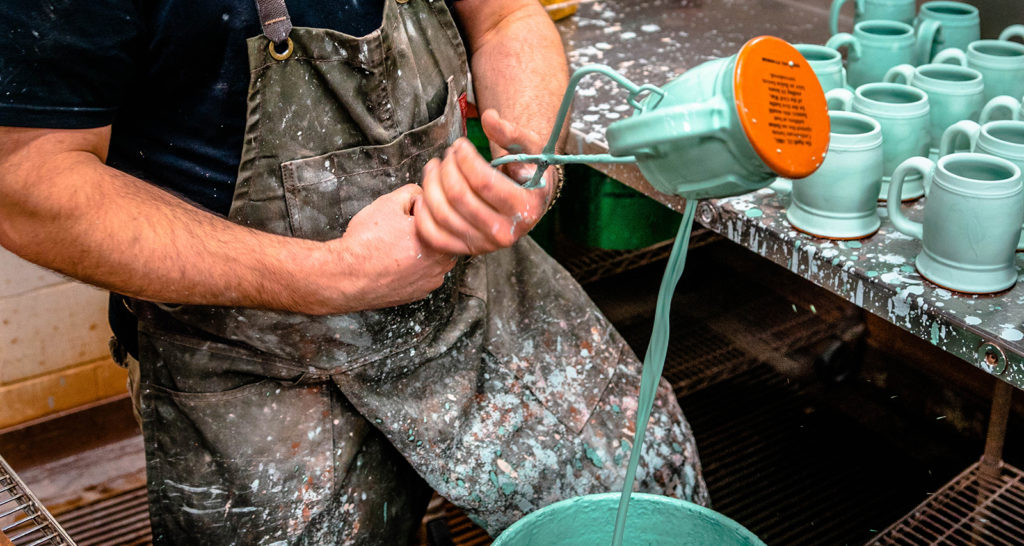
All About Ceramic Glazes
One of the things that makes stoneware unique is the ceramic glaze on the outside. Glazes add color and strength, and they make your coffee mug and beer steins impermeable. But, the process of making glazes belongs somewhat to nature. To help you understand how that process works, we’ve come up with this definitive guide that shows you all about ceramic glazes, from how we make them to how they can change over time.
How Does Ceramic Glaze Work?
Ceramic glazes make stoneware impenetrable to liquids like water and oil. The reason why this works is because the glaze vitrifies, or turns to glass, when you expose it to the high temperatures of a kiln. It might look like we just paint our pottery to give it color, but that’s not quite true. The process is actually more involved.
Ceramic Glazing 101
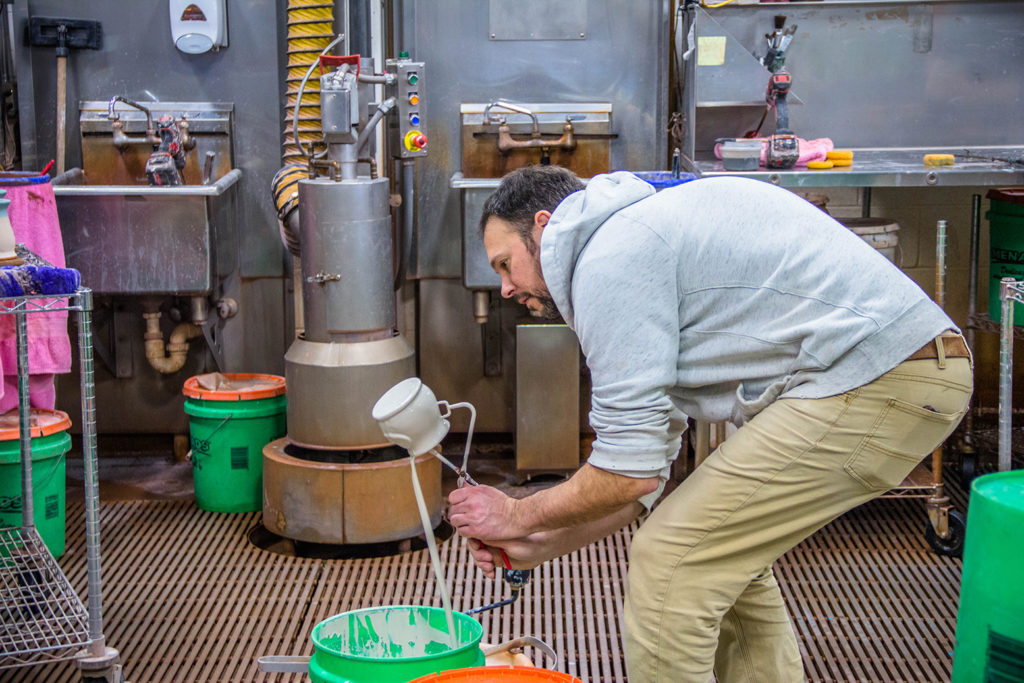 Glazes are made of minerals, oxides and other chemical compounds that come from mines all over the United States, in our case. When combined with water, they form a slurry, which we dip the mug into all at once with a pair of tongs in order to give it color.
Glazes are made of minerals, oxides and other chemical compounds that come from mines all over the United States, in our case. When combined with water, they form a slurry, which we dip the mug into all at once with a pair of tongs in order to give it color.
However, getting the glaze onto the mug and making sure it stays there isn’t as easy as it looks. It requires precise timing and movement to do it right. Otherwise, if the mug spends too much or too little time in the glaze, the color could slip off of the mug during firing, leaving bald patches.
Glazes dry quickly. Within a matter of minutes, it reaches a chalky texture on your mugs. But, it’s important for us to note that some dry faster than others, to the extent that our glazing team sometimes has to blow on certain glaze colors to make sure they don’t run out of the medallion before they harden.
Many of our glaze colors are two-toned. Some are even tricolor. Mugs with these glazes take a bit more time to finish glazing, because we have to wait for the first layer of glaze to dry before we dip the top or bottom into the second glaze color. Depending on the glaze, this process can take anywhere from a few seconds to several minutes.
However, all of our glazes have one thing in common: None of them contain lead, cadmium or other dangerous chemicals. All of our mugs are safe to use with your coffee, snacks or anything in between.
How Heat Changes Glaze Colors
Some glaze colors leave the kiln looking starkly different from how they entered.
To get this color change, we have to expose the glazed mugs to extremely high temperatures. We’re not talking ovens; we’re talking volcanoes. The extreme heat allows glazes that go in beige to come out bright blue, or go from pale blue to pitch black. Heat can also make the glaze go from a chalky matte finish to glossy.
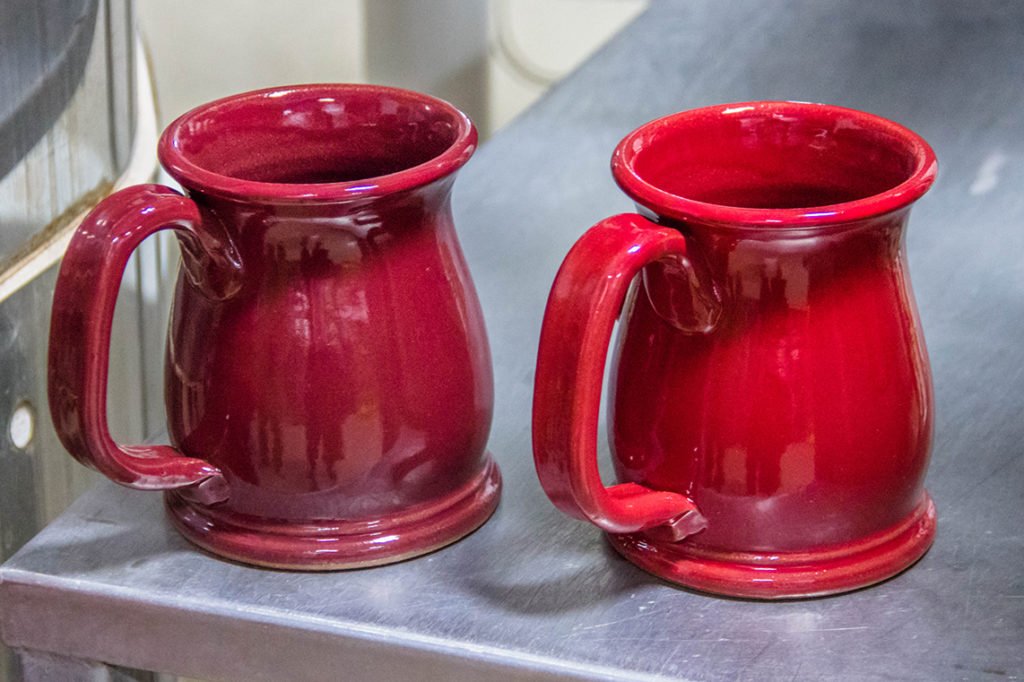
Choosing the right temperatures also takes some knowledge and skill. After all, the difference between two glaze colors is sometimes just a few degrees of heat in the kiln.
Time is another big part of the equation. It takes hours of sitting in those white-hot temperatures to get the color and finish we want. Cooling the mugs down too quickly can discolor them or give them a matte or semi-gloss finish.
In some cases, the color we’re looking for doesn’t show up until the mug is in the final stages of cooling down. Red doesn’t reach its brightest shade until after it cools completely. Electric Blue only shows its full brilliance after the kilns are below oven temperatures. Taking mugs in almost any color out too early can shock them before the full color gets to come out. That’s why our glazing team has to open the kilns up in slow stages, often over the course of several hours each morning.
How We Come Up with New Ceramic Glaze Colors
Once in a while, our crack team of mad glazing scientists gets to experiment. Sometimes, when they play with new ideas, that’s our chance to debut new colors for your mugs.
There’s a lot of trial and error in making new ceramic glaze colors. We might come up with a completely new recipe, or combine existing glazes to see how different colors work together. The latter method is how we got Toasted S’more, Desert Cactus and Blueberry Muffin, along with a slew of other combinations. Sometimes, it doesn’t work. But, when it does, we keep working with the glaze until we know it’s stable on a variety of shapes.
Lastly, we have to name the glaze right before it makes its official debut. Sometimes, we like to use crowdsourcing with our fans on Facebook and Instagram to come up with new names. However, our shop has been a source of some wonderfully creative names over the past few years. Blarney Stone, Denim Tuxedo and Cherry Cola were the brainchildren of our shop crew. We find it fitting, since these are the same people who get to work with the glazes they name every day.
Why Some Glazes Turn Out Differently on Some Mugs
Glazes might make your mug impervious to liquid, but glazes themselves are not impervious to gravity. The general shape and slope of a mug can change how glazes look on certain styles. A host of other factors plays into how the glaze will turn out on each mug, including how long they’re submerged and the mineral content of each color. Here are just a few factors that play into the final results.
They’re Thick (or Sometimes Thin)
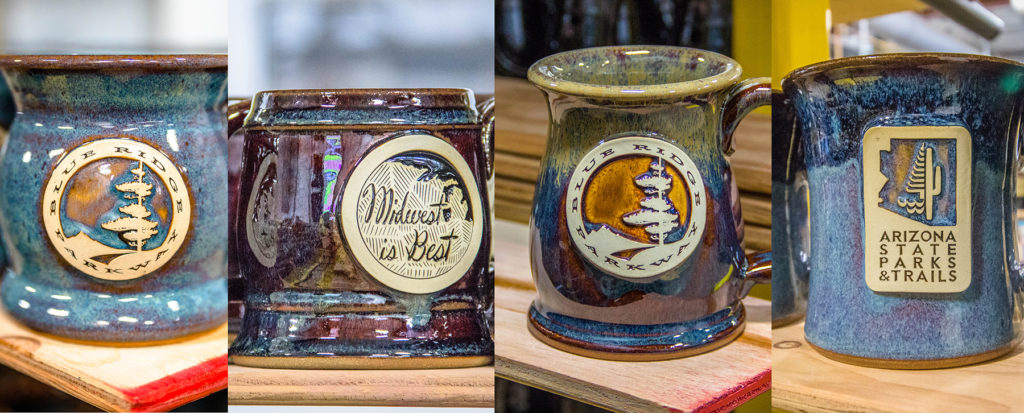 How the glaze looks as a final product can depend on its viscosity, or its thickness. We like for our glazes to be somewhere around wet paint or the chocolate in a chocolate fountain when they’re liquid, depending on which glaze it is. But, some can be thicker, and some can be much thinner.
How the glaze looks as a final product can depend on its viscosity, or its thickness. We like for our glazes to be somewhere around wet paint or the chocolate in a chocolate fountain when they’re liquid, depending on which glaze it is. But, some can be thicker, and some can be much thinner.
For example, Root Beer has brilliant, subtle shades of blue and purple that come out in the sunlight. While Root Beer and its sister glaze Root Beer Float are fan favorites for this kaleidoscope of color, they’re also thin by nature. The thinness of the glaze causes it to turn orange around the ridges of the mug and inside the medallion, especially the design has large, open spaces. The same also applies to Root Beer Float, despite it having a golden-yellow top.
Since Stormy Blue is also a thin glaze, mugs with it and Night Sky can also have orange, worn-looking edges around the handles and base of the stoneware. That same orange effect can also appear inside the medallion. We like this effect because it makes the color that much more distinct from lesser-quality mugs, but it’s also why we discourage pairing medallion designs with big, open spaces with Stormy Blue or Night Sky.
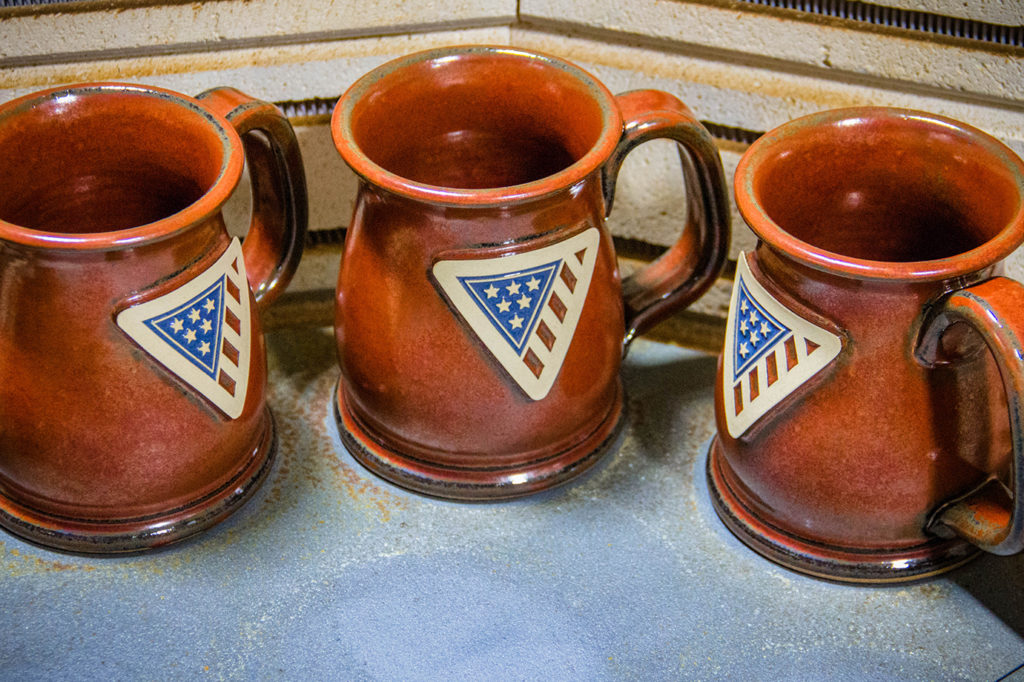
Other relatively thin glazes include Seafoam, Frosty Flake and colors based in Mulberry Blush. All of these can have distressed edges, and some even need to have black infill inside their medallions, in the case of Seafoam and Frosty Flake.
On the thicker end of the spectrum are glazes like Sunfire Red and Brilliant Blue. These glazes are thicker by nature and so stable that we can even use them as custom infill. While Sunfire Red naturally has some dark-colored spots on the edges of handles and just outside the medallion, it performs beautifully as an infill. Brilliant Blue is solid and almost always reliable, so we love including it in pieces with custom medallions.
Double-Dip Glazes
During the firing process, the top half of a double-dipped color sometimes pools around the edge of your medallion, making it look like the glaze dripped around the top and sides of the medallion. You might notice this effect on some styles more than others.
For example, Northern Lights exudes beauty with its swirling topper. However, on curvy styles like the Potbelly, the top glaze sometimes drips down further during firing.
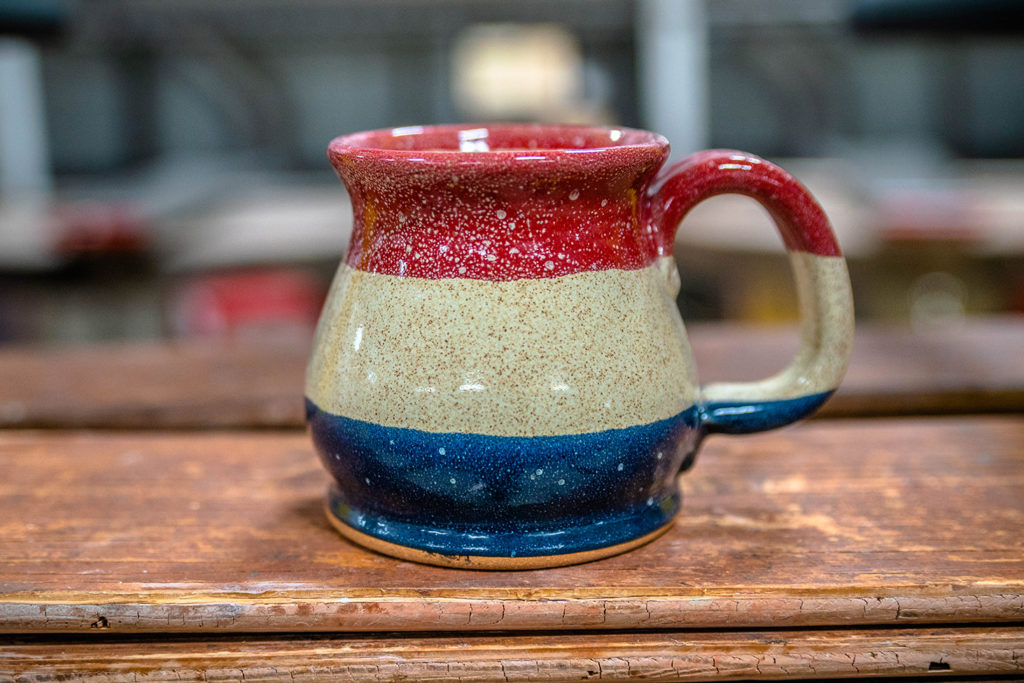
The shape of the medallion can also make a difference. Round medallions have this effect more often, along with designs that come to a point at the top. This effect is less prominent on square or rectangular medallions.
Tricolors and Bottom Glazes
It took us months of trial and error to get to a point where we could offer tricolor glazes to our customers. We had to experiment with different base colors to make sure the glaze wouldn’t slip off the edge of the mug. Ultimately, we chose to use Oatmeal as a base for our tricolors, which had a more distressed, almost vintage feel than Frosty Flake. Despite how it gave the early versions of Old Glory spots all across the mug, it proved to be a stabler base for our tricolor experiments than other options we tried.
With the formula mastered for the red, white and blue vibe of Old Glory, we were able to expand our arsenal for a few more tricolor options. A few months later, we added the festive and surprisingly diverse Poinsettia and the Irish-flavored Blarney Stone.
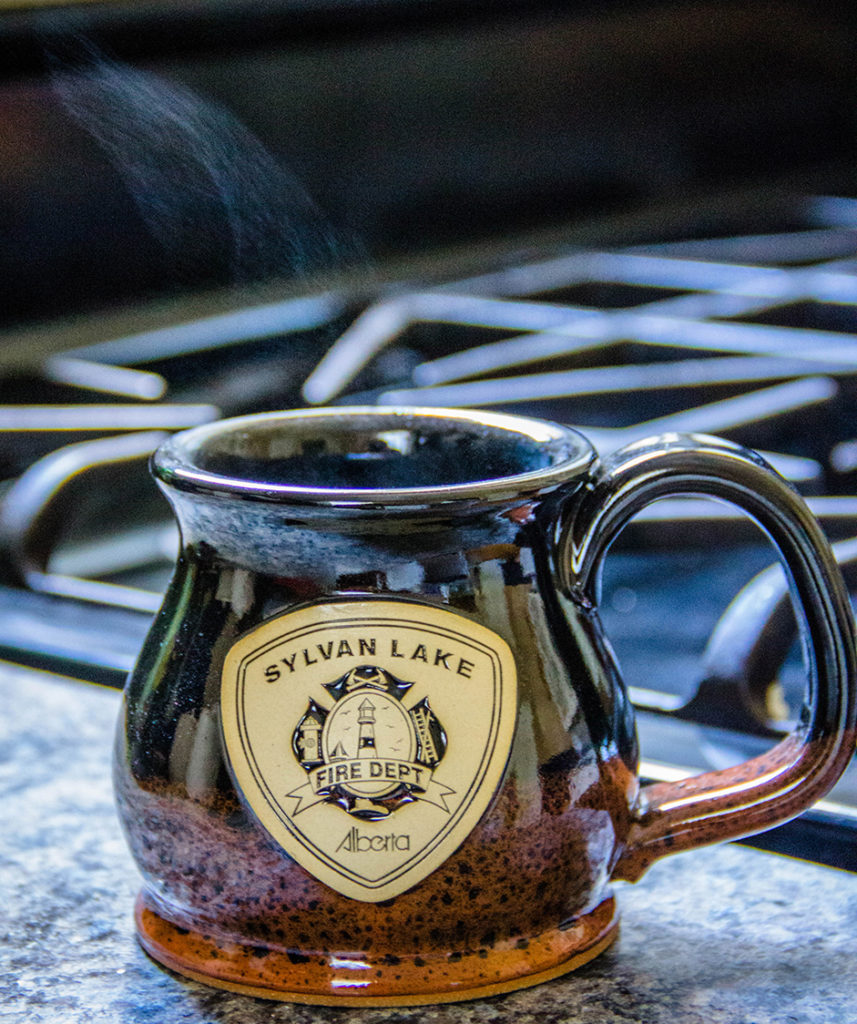 Like with all of our two-tone glazes, the drip lines on our tricolor glazes can vary, depending on the style and how the glaze moves as it dries.
Like with all of our two-tone glazes, the drip lines on our tricolor glazes can vary, depending on the style and how the glaze moves as it dries.
Right now, we only offer one glaze that has a double dip on the bottom: Brimstone. As cool as this glaze looks in person, there’s a reason we only offer it on styles that curve outward at the base. Without that curved base, the fiery orange glaze runs right off the bottom of the mug. That being said, the orange may go higher or lower on any given mug, depending on how our crew dips it and how it reacts in the kiln.
Why We Retire Glazes—And Why They May or May Not Come Back
We’ve had to retire some glazes in the past. While we wish we didn’t have to, we usually do it because we care about the quality of our product.
The mineral composition of our glazes can always vary in tiny, usually unnoticeable ways. Because the chemistry of certain minerals can change depending on the elements around it, the viability of certain glazes has changed over time. Sometimes we can correct the changes and bring the glaze back, but other colors have had to retire permanently.
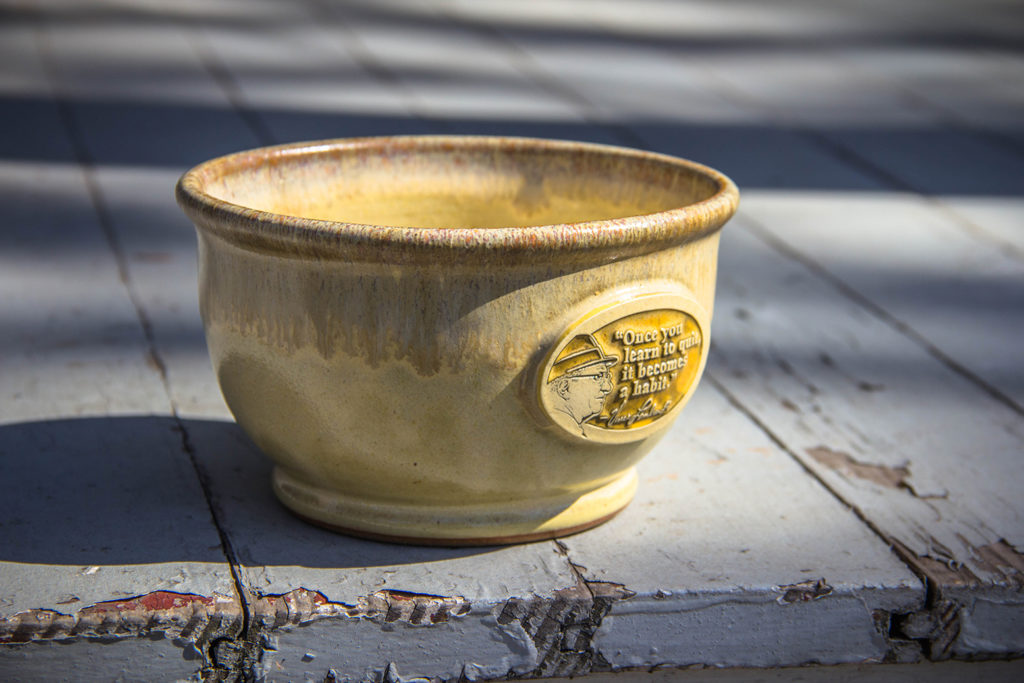 Honeycomb and Honeysuckle
Honeycomb and Honeysuckle
If you look at our Glaze Gallery, you might see that we have every color of the rainbow, except one—yellow. We used to have Honeycomb and Honeysuckle, two springtime yellow colors, one of which had a unique, cream-colored topper. However, we had to retire them both for quality control reasons.
Our mad scientists have a yellow glaze in the works. While it won’t be exactly the same as Honeycomb, it still completes our rainbow and makes your mugs stand out like a beacon in the crowd.
Moonberry
This far-out purple glaze was unique because it had mysterious blue flecks all over it. However, its age of Aquarius was short. We had to go back to the drawing board after about a year because it wasn’t meeting our rigorous quality standards.
However, a few months later, we crowned a replacement: Imperial Purple. What it lacks in blue spots, it now makes up for in regal bearing. It’s solid and more elegant than ever, making it even more diverse than the original.
Summer Blue and Summer Time Blues
This powdery blue was a popular choice for years. It also had a two-tone cousin in Summer Time Blues, which had a greenish-yellow topper that made it quite a collector’s piece. While these glazes live on in our showroom, we had to retire them both because they left noticeable bald patches on our mugs after coming out of the kiln.
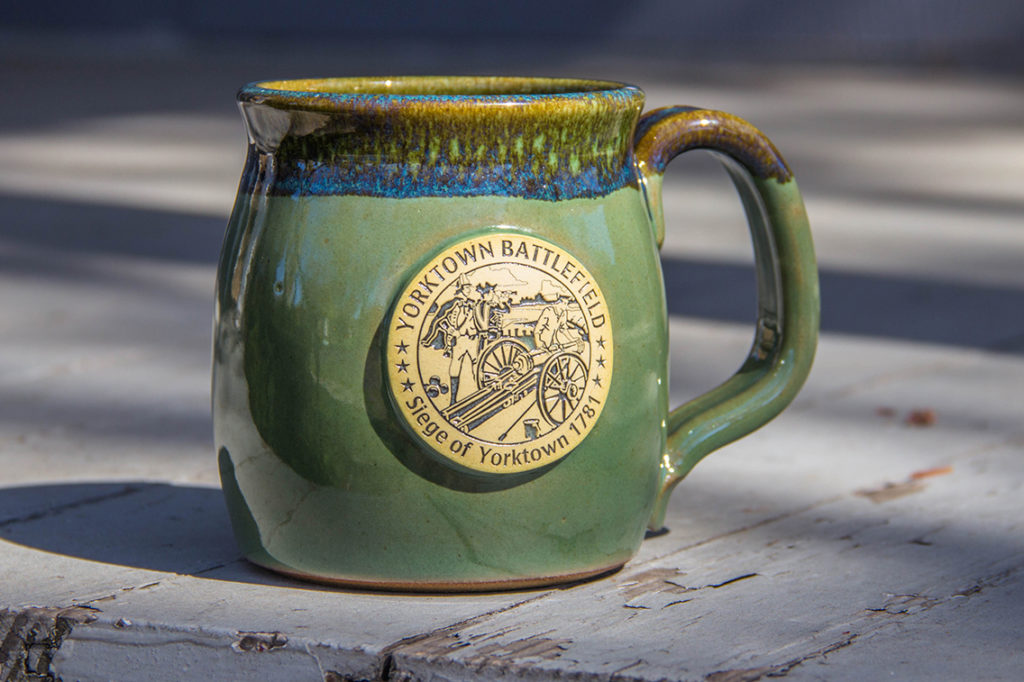
Sadly, we haven’t been able to recreate Summer Blue yet. However, we have been experimenting with other light blue glazes in our free time, so stay tuned.
Ivy Mist
For years, Ivy Mist took our familiar Lily Pad glaze and added a blue top that reminded us of opals or stained glass. It was a popular glaze among the lovers of all things vintage. However, that beautiful blue top began to fall below our quality standards, so we were forced to retire it.
We don’t know if we’ll ever be able to bring back Ivy Mist, given our current supply of minerals for glazing. Mugs, steins and other pieces in this unusual color combination are collector’s pieces, and we encourage anyone who finds them in the field to hold onto them.
Iced Orange
A sherbet-orange glaze with a layer of white on top, we had to pull Iced Orange and a few other glazes because the composition of the topper began to run off during firing.
However, during some recent downtime, we tweaked the formula for Iced Orange. Slowly but surely, the Popsicle-flavored color is making a comeback. Keep an eye out for it at your favorite local coffee shops.
How Colors May Vary from One Batch of Mugs to the Next
Because the minerals in glazes come from the earth, there may be very slight chemical differences that make the colors change on different mugs. Even the shape of the stoneware can affect how certain colors turn out. Plus, sometimes we tweak glaze recipes to make them more stable over time. Here are some of the glazes where you’re most likely to notice these minute changes between batches.
Pink Passion
If you’ve been with us for a while, you might have noticed older mugs in Pink Passion have light pink flecks all over them. This was a trait the glaze had in its earliest days, but we’ve since refined our formula. Now, it’s a solid, pastel shade of pink without a single spot in sight. We recommend it if you want a solid glaze that stands out in the crowd.
Copperhead Run
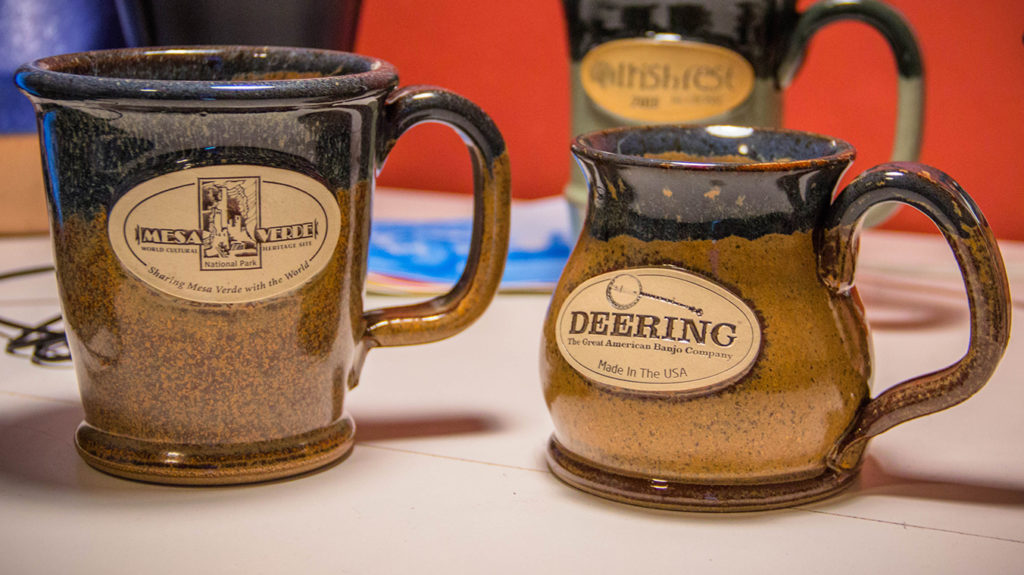 Copperhead Run is easily one of our most popular glazes. It’s rustic and beautifully detailed thanks to the combination of a Sandstone base and a blue-green top with lighter streaks and swirls. However, both colors in the glaze can have some variation. In some batches, the golden-brown Sandstone base can appear more solid, or sometimes has dark brown and tan flecks. Similarly, the top might appear more blue or greenish, or have flecks of its own in some batches.
Copperhead Run is easily one of our most popular glazes. It’s rustic and beautifully detailed thanks to the combination of a Sandstone base and a blue-green top with lighter streaks and swirls. However, both colors in the glaze can have some variation. In some batches, the golden-brown Sandstone base can appear more solid, or sometimes has dark brown and tan flecks. Similarly, the top might appear more blue or greenish, or have flecks of its own in some batches.
Part of this has to do with minor mineral differences in each batch of glaze. We love this about Copperhead Run though. It shows that when we say that each of our mugs is a unique work of art, we mean it.
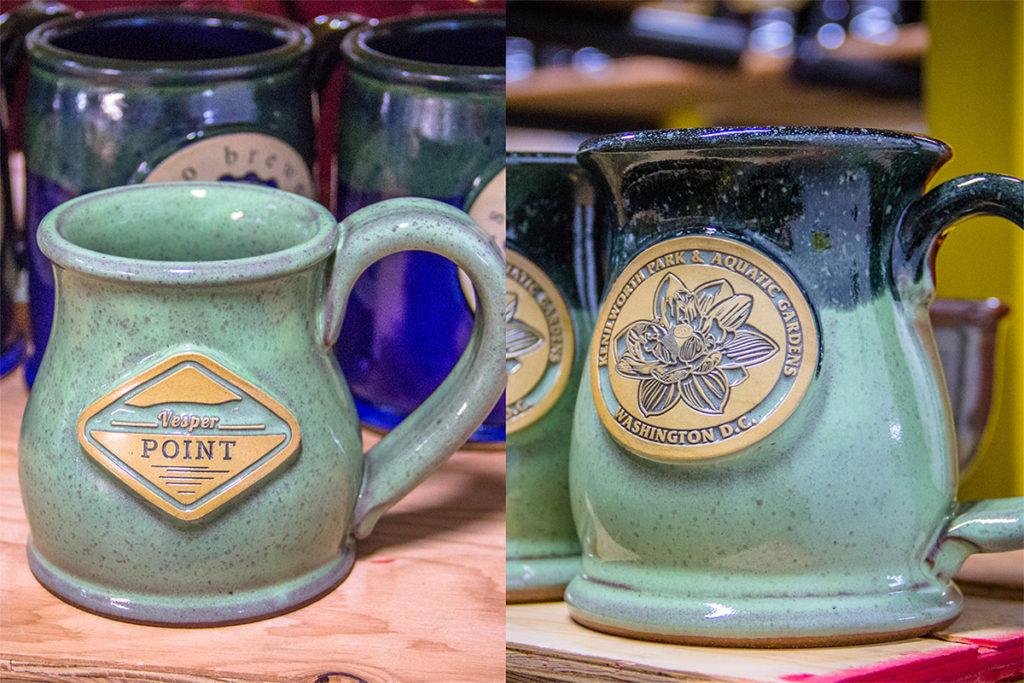 Pistachio and Mustachio
Pistachio and Mustachio
These two colors use a springy shade of green with light brown flecks. Mustachio uses that as a base and tops it with a darker shade of green, which typically has light green spots as well. We love this glaze for the tinkling noise it makes as it cools in our shipping area, and for the unusually dark yellow medallion it tends to bring with it.
The biggest changes you might notice in these glazes is the density of the flecks on each mug between batches. While all mugs in Pistachio and Mustachio will have them, they may appear more dense or scattered in different sets. Such is the nature of the glaze.
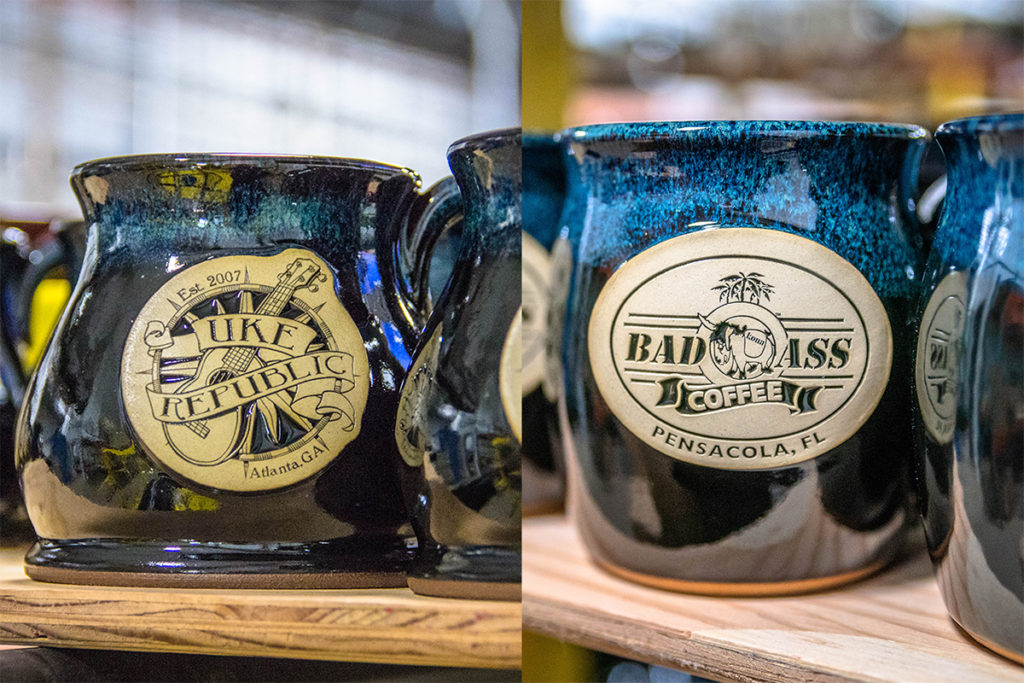 Galaxy Night
Galaxy Night
Another crowd favorite, Galaxy Night takes our Midnight Black glaze and tops it with a blue shade that almost seems to shimmer like a Van Gogh painting. However, sometimes the blue topper can look more pronounced on some mugs. You might even see a few greenish undertones on some oft them. When the glaze is more subtle though, it can be a treat to look at in the early-morning light.
Some might balk at the idea of a product that can change in small ways so easily, but we think that’s part of what makes Galaxy Night so popular with mug collectors.
Amethyst Horizon
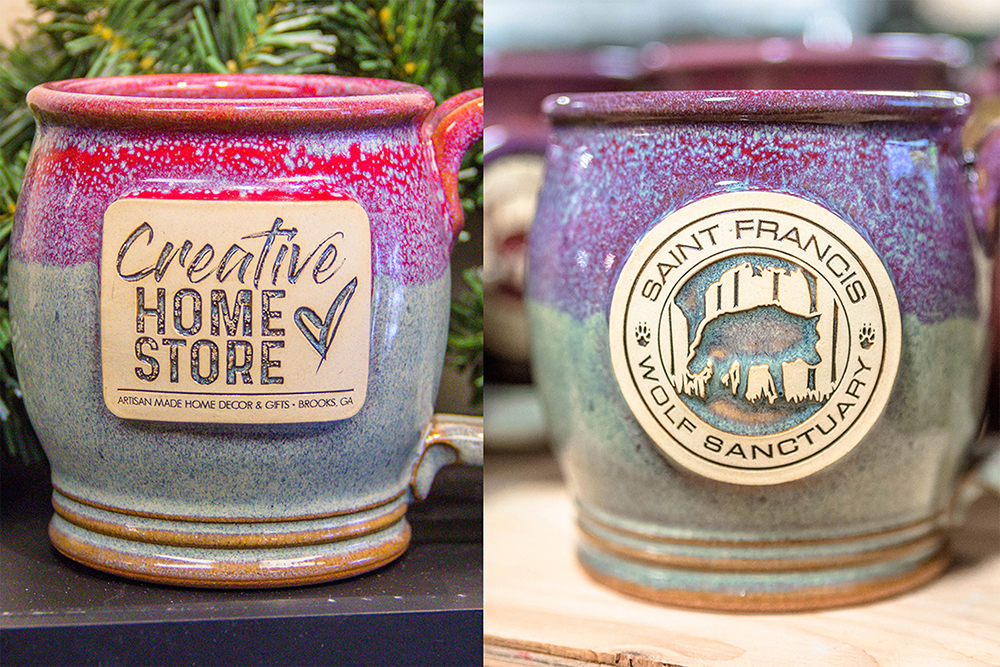 This jewel-toned glaze takes a blue-green base and pairs it with a reddish-purple that reminded us of a sunrise; hence the name. Amethyst Horizon is unique because we fire it exactly the same way we fire Red. However, sometimes the top glaze can do some genuinely fascinating things under the right conditions.
This jewel-toned glaze takes a blue-green base and pairs it with a reddish-purple that reminded us of a sunrise; hence the name. Amethyst Horizon is unique because we fire it exactly the same way we fire Red. However, sometimes the top glaze can do some genuinely fascinating things under the right conditions.
While it’s usually on the bluer end of purple, sometimes the top can veer toward a more solid, redder shade. We love when this happens, and so do the people who will use your custom coffee mugs.
Some glazes are stabler than others. But, none of them are safe from the tides of change if the minerals we use in them begin to change with them. Almost any of our glaze colors can change from mug to mug, especially if we’re putting the same color onto two very different shapes. While the process of making them will almost always be the same, the glazes themselves are as subject to change as any true work of art.
To view all of our over 70 glaze color options for yourself and get a quote for your own custom ceramic mugs, check out our Glaze Gallery.

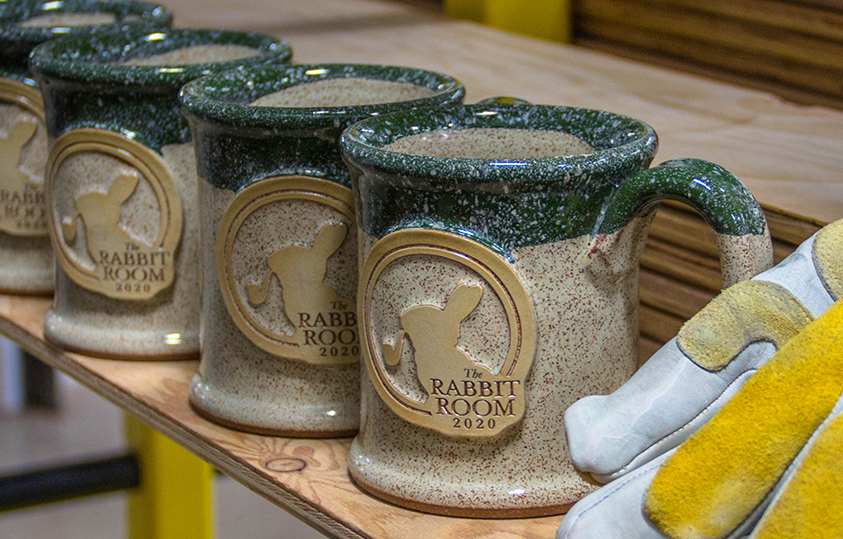
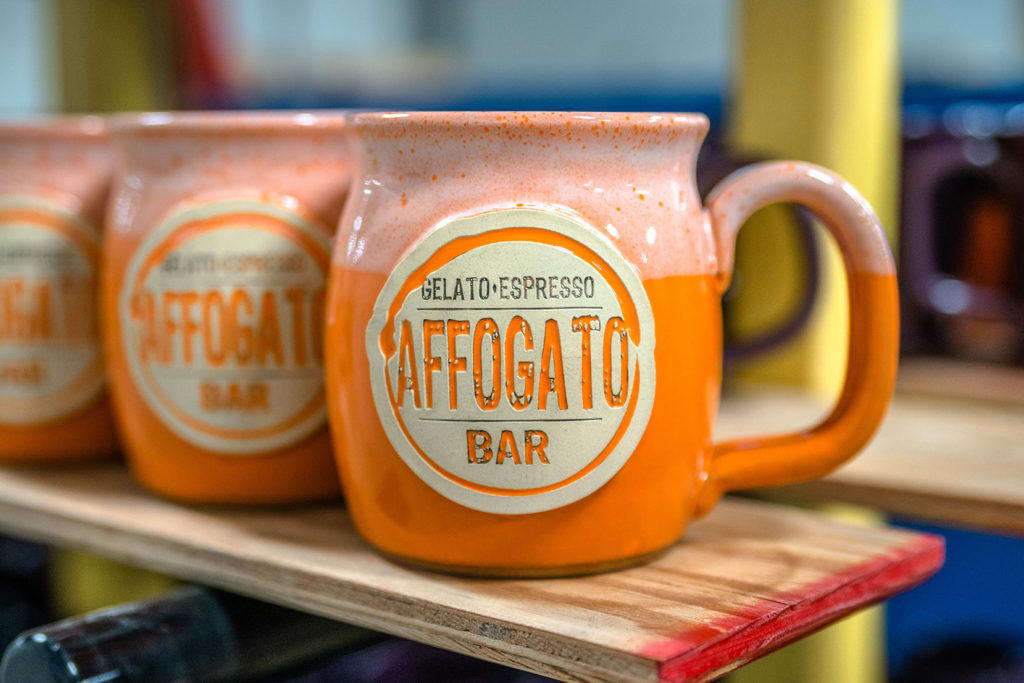
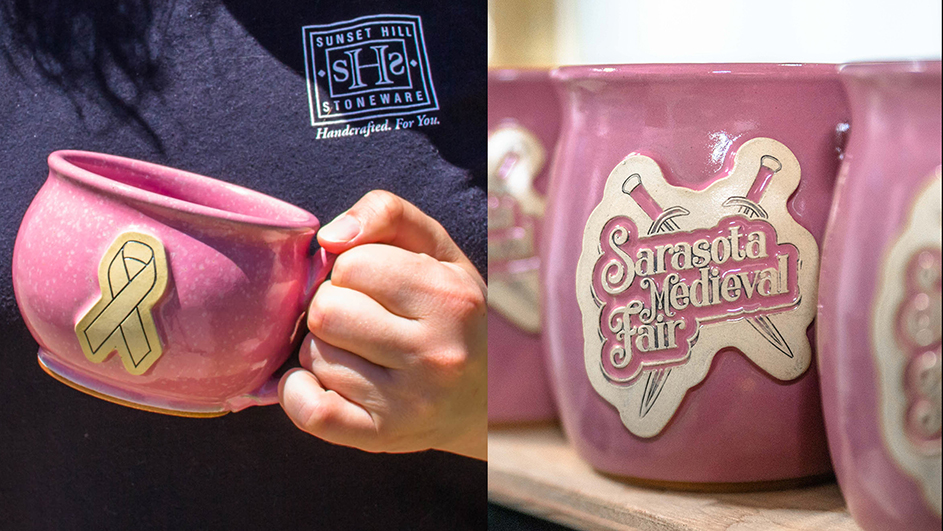

[…] with earlier steps in the process of making your promotional coffee mugs, timing is everything with glazing. Even when we’re dipping the mug into the glaze with a pair of tongs, spending too little or […]